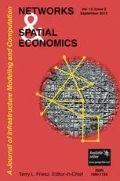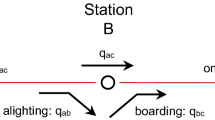Abstract
The paper presents a route choice model for dynamic assignment in congested, i.e. overcrowded, transit networks where it is assumed that passengers are supported with real-time information on carrier arrivals at stops. If the stop layout is such that passenger congestion results in First-In-First-Out (FIFO) queues, a new formulation is devised for calculating waiting times, total travel times and route splits. Numerical results for a simple example network show the effect of information on route choice when heavy congestion is observed. While the provision of information does not lead to a remarkable decrease in total travel time, with the exception of some particular instances, it changes the travel behaviour of passengers that seem to be more averse to queuing at later stages of their journey and, thus, prefer to interchange at less congested stations.




Similar content being viewed by others
References
Billi C, Gentile G, Nguyen S, Pallottino S, Barrett K (2004) Rethinking the wait model at transit stops. Proceedings of TRISTAN V - Triennial Symposium on Transportation Analysis, 2004
Black JA, Paez A, Suthanaya PA (2002) Sustainable urban transportation: performance indicators and some analytical approaches. J Urban Plan Dev 128(4):184–192
Bouzaïene-Ayari B (1988) Modélisation des arrêts multiples d’autobus pour les réseaux de transport en commun., École Polytechnique de Montréal
Bouzaïene-Ayari B, Gendreau M, Nguyen S (2001) Modeling bus stops in transit networks:a survey and new formulations. Transp Sci 35:304–321
Cantarella GE (1997) A general fixed-point approach to multi-mode multi-user equilibrium assignment with elastic demand. Transp Sci 31(2):107–120
Cepeda M, Cominetti R, Florian M (2006) A frequency-based assignment model for congested transit networks with strict capacity constraints: characterization and computation of equilibria. Transp Res B Methodol 40:437–459
Chabini I (1998) Discrete dynamic shortest path problems in transportation applications: complexity and algorithms with optimal running time. Transp Res Rec J Trans Res Board 1645:170–175
Chriqui C, Robillard P (1975) Common bus lines. Transp Sci 9:115–121
Cominetti R, Correa J (2001) Common-lines and passenger assignment in congested transit networks. Transp Sci 35:250–267
De Cea J, Fernandez E (1993) Transit assignment for congested public transport systems: an equilibrium model. Transp Sci 27:133–147
European Commission (2009) A sustainable future for transport: towards an integrated, technology-led and user friendly system. COM(2009) 279 final
Gallo G, Longo G, Pallottino S, Nguyen S (1993) Directed hypergraphs and applications. Discret Appl Math 42:177–201
Gao S (2012) Modeling strategic route choice and real-time information impacts in stochastic and time-dependent networks. Intell Transp Syst, IEEE Trans 13(3):1298–1311
Gao S, Frejinger E, Ben-Akiva M (2010) Adaptive route choices in risky traffic networks: a prospect theory approach. Transp Res C Emerg Technol 18(5):727–740
Gendreau M (1984) Étude approfondie d’un modéle d’équilibre pour l’affectation des passangers dans les réseaux de transport en commun. PhD, Université de Montréal
Gentile G, Nguyen S, Pallottino S (2005) Route choice on transit networks with online information at stops. Transp Sci 39:289–297
Grotenhuis J-W, Wiegmans BW, Rietvel P (2007) The desired quality of integrated multimodal travel information in public transport: customer needs for time and effort savings. Transp Policy 14:27–38
Hamdouch Y, Lawphongpanich S (2008) Schedule-based transit assignment model with travel strategies and capacity constraints. Transp Res B Methodol 42:663–684
Hamdouch Y, Marcotte P, Nguyen S (2004) A strategic model for dynamic traffic assignment. Netw Spat Econ 4:291–315
Hamdouch Y, Ho HW, Sumalee A, Wang G (2011) Schedule-based transit assignment model with vehicle capacity and seat availability. Transp Res B Methodol 45:1805–1830
Hickman MD, Wilson NHM (1995) Passenger travel time and path choice implications of real-time transit information. Transp Res C Emerg Technol 3:211–226
Kurauchi F, Bell MGH, Schmöcker JD (2003) Capacity constrained transit assignment with common lines. J Math Model Algoritm 2:309–327
Leurent F, Benezech V (2011) The passenger stock and attractivity threshold model for traffic assignment on a transit network with capacity constraint. Transportation Research Board, 90th Annual Meeting. Washington, D.C.
Miller-Hooks ED, Mahmassani HS (2000) Least expected time paths in stochastic, time-varying transportation networks. Transp Sci 3(2):198–215
Newman P, Kenworthy JR (1999) Sustainability and cities: overcoming automobile dependence. Island Press. Washington, D.C.
Nguyen S, Pallottino S (1988) Equilibrium traffic assignment for large scale transit networks. Eur J Oper Res 37:176–186
Nguyen S, Pallottino S, Gendreau M (1998) Implicit enumeration of hyperpaths in a logit model for transit networks. Transp Sci 32:54
Noekel K, Wekeck S (2007) Choice models in frequency-based transit assignment. European Transport Conference 2007
Pretolani D (2000) A directed hypergraph model for random time dependent shortest paths. Eur J Oper Res 123(2):315–324
Schmöcker J-D, Bell MGH, Kurauchi F (2008) A quasi-dynamic capacity constrained frequency-based transit assignment model. Transp Res B Methodol 42:925–945
Spiess H (1983) On optimal route choice strategies in transit networks. In Centre De Recherche Sur Les Transports, UDM (ed)
Spiess H (1984) Contributions á la téorie at aux outils de planification des résaux de transport urbain. Ph.D. Thesis Ph.D. Thesis, Université de Monteréal
Spiess H, Florian M (1989) Optimal strategies: a new assignment model for transit networks. Transp Res B Methodol 23:83–102
Teklu F (2008) A stochastic process approach for frequency-based transit assignment with strict capacity constraints. Netw Spat Econ 8:225–240
Trozzi V, Gentile G, Bell MGH, Kaparias I (2013) Dynamic user equilibrium in public transport networks with passenger congestion and hyperpaths. Transp Res B Method, in press doi:10.1016/j.trb.2013.06.011
Ukkusuri SV, Patil G (2007) Exploring user behavior in online network equilibrium problems. Transp Res Rec J Transp Res Board 2029:31–38
Yang B, Miller-Hooks ED (2004) Adaptive routing considering delays due to signal operations. Transp Res B Methodol 38(5):385–413
Author information
Authors and Affiliations
Corresponding author
Rights and permissions
About this article
Cite this article
Trozzi, V., Gentile, G., Kaparias, I. et al. Effects of Countdown Displays in Public Transport Route Choice Under Severe Overcrowding. Netw Spat Econ 15, 823–842 (2015). https://doi.org/10.1007/s11067-013-9207-5
Published:
Issue Date:
DOI: https://doi.org/10.1007/s11067-013-9207-5




